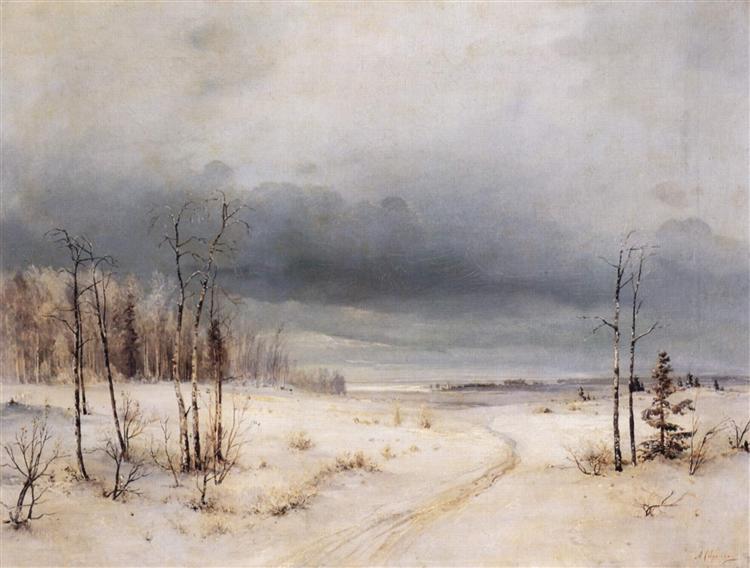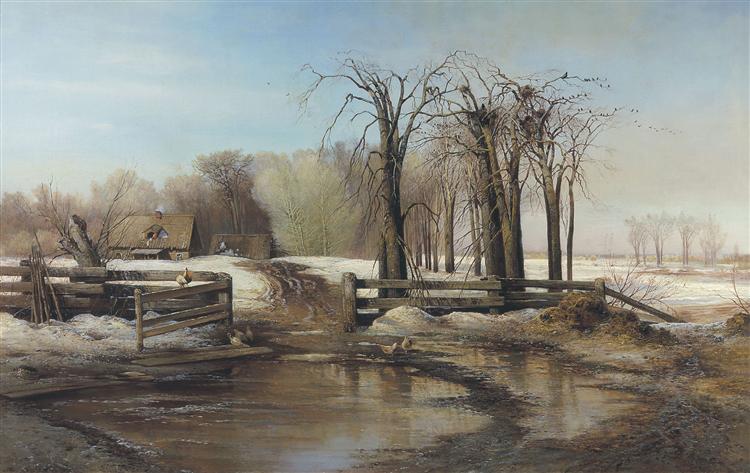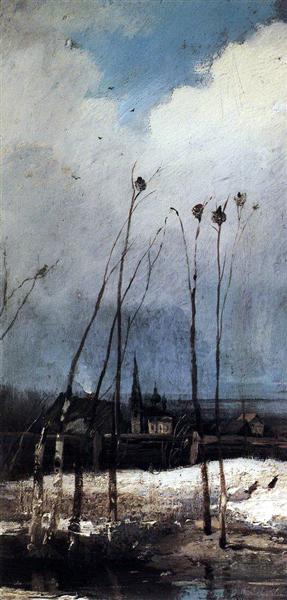Tags
Aleksei Savrasov, Romanticism, the Imperial Academy of Arts, the industrial revolution, the Lyrical Landscape, the MSPSA, the Peredvizhniki, the Transitional & Eternal

Early Spring Thaw by Aleksey Savrasov, 1785 (Wikiart.org.)
Early Days and Education
- a Romantic
I have mentioned Savrasov (1830 – 1897) in two earlier posts. In one of these posts, I combined a short discussion of the artist and a list of newspapers. I also wrote that Aleksey Savrasov was Isaac Levitan’s teacher and had been a member of the Peredvizhniki group. The Peredvizhniki (the Wanderers) group protested academic restrictions. I will add that, at the beginning of his career, Savrasov’s paintings were considered Romantic. The romantics expressed sentiment and individualism as their country entered its Industrial Age, William Blake‘s “dark, satanic mills.”
Savrasov was born in Moscow and studied at the Moscow School of Painting, Sculpture and Architecture (MSPSA) under professor Karl Rabus (1800-1857). In 1852, Sarasov traveled to the Ukraine. Then, in 1854, the Grand Duchess Maria Nikolayevna, President of the Imperial Academy of Arts, commissioned several works from him. Savrasov therefore moved to Oranienbaum, near Saint Petersburg.
Oranienbaum
“View in the Neighbourhood of Oranienbaum,” 1754, earned Savrasov his membership in the Russian Academy of Arts.

View in the Neighourhood of Oranienbaum, Aleksey Savrasov, 1854 (Wikiart.org.)
In 1854, Savrasov’s View in the Neighbourhood of Oranienbaum (1854), earned him membership in the Imperial Academy of Arts. By the invitation of the Grand Duchess Maria Nikolayevna, President of the Imperial Academy of Arts, he moved to the neighbourhood of St. Petersburg.

Winter by Aleksei Savrasov, 1873 (Wikiart.org.)

Winter by Aleksei Savrasov, 1870 (Wikiart.org.)
The Moscow School of Painting, Sculpture and Architecture (MSPSA)
- a teacher
- a friendship with Vasily Perov
- a rich social life
In 1857, the year Savrasov married Sophia Karlevna Hertz, the sister of art historian Karl Hertz (1820-1883), he became a teacher at the Moscow School of Painting, Sculpture and Architecture (MSPSA). His best students were Isaac Levitan and Konstantin Korovin, who had fond memories of him.
In Moscow, he and his wife entertained art lovers and art collectors, including Pavel Tretyakov, who gave his art gallery to Russia in 1892. At this time in his life, Savrasov had a fine and productive relationship with artist Vasily Perov. Savrasov helped Perov paint his Bird catcher and Hunters on Bivouac and Perov helped Savrasov paint the boat trackers in his Volga.
The International Exhibition in England
- England
- Switzerland
In 1662, Savrasov travelled to Europe to see England’s International Exhibition and also went to visit Switzerland. The lesson he drew from visiting the International Exhibition in England was that no academies could so promote an artist as an international exhibition. (See Aleksey Savrasov, Wiki2.org.)
Alcoholism and Death
In the late 1870s, after the death of this daughter, Savrasov became an alcoholic. No one could help. In 1882, he was dismissed from the MSPSA. The following line is very moving: “Only the doorkeeper of the MSPSA and Pavel Tretyakov, founder of the Tretyakov Gallery, were present at his funeral in 1897.” (See Aleksey Savrasov, Wiki2.org.)
.jpg!Large.jpg)
The Rooks have returned by Aleksey Savrasov, 1871 (Wikiart.org.)

A Spring Day by Aleksei Savrasov, 1873 (Wikiart.org)
Comments
- masterpieces
- the transitional & the eternal
- the lyrical landscape
Savrasov’s “The Rooks have returned” (1871) is considered one of his finest, if not his finest, painting. But so many of Savrasov’s paintings are masterpieces that saying one is the best is a genuine challenge.
For instance, “A Spring Day” (1873) is perfection and it touches us because it depicts the beginning of a season. Human beings have painted the seasons for a very long time and they have kept Books of Hours. Jean de France, duc de Berry‘s Très Riches Heures depicts each month of the year and its labour. Savrasov’ paintings often portray transitions and, therefore, renewal They show the end or beginning of a season, the end of winter, in particular. Seasons follow seasons eternally. Life rises again, irrepressibly.
Note that smoke comes out of the chimney of the first little brown homes. Until now, the Industrial Revolution, humans have protected themselves. We have dealt with the elements, found a refuge and built roads and fences. The pale green of trees in the background allows us to get a clear view of the disheveled trees burgeoning.
From the point of view of composition, “A Spring Day” has several golden sections. A golden section/ratio resembles an off-center crucifix. One of two lines, an horizontal and a vertical line, is longer than the other line. “A Spring Day” shows a long horizontal line that crosses a vertical line. The meeting point is a group trees. Perspective is achieved by the change in colouring from dark to pale. Moreover, there is a road, or vanishing point (le point de fuite). There is no flaw in the composition of “A Spring Day.”
The sky sits above a long arched line supported by small trees on the right and the bulkier houses on the left.
“A Spring Thaw,” the painting placed at the beginning of this post, combines diagonal and other lines. They are hints of Japonisme. Moreover, the colouring is very smooth.
Savrasov’s softens his landscapes as though each were a praise of nature and a prayer.
RELATED ARTICLE
- The Art of Isaac Levitan (8 December 2018)
Sources and Resources
Love to everyone 💕
On the music of Sergei Prokofieff
Basso profondo as accompaniment

The Rooks have arrived by Aleksey Savrasov, 1880 (Wikiart.org)
© Micheline Walker
27 December 2018
WordPress


I’ve always felt that Savrasov’s paintings were somewhat depressive, but then so is the Russian winter (to me, that is). Thank you for Prokofiev, dear Micheline!
LikeLike
Thank you. Savrasov is a poet. I had difficulty finding a video with Russian music. Fortunately, I found Prokofiev.
My best regards.
LikeLiked by 1 person
Savrasov is a melancholy poet; at least that’s my feeling.
Have a great weekend!
LikeLike
He was fragile and created beauty. His paintings are poetry. Take care, Micheline
LikeLiked by 1 person
Savrasov is certainly a poet but how sad about his alcoholism later in life. And, of course, I loved the video with the basso profondo.
LikeLike
Savrasov is a marvellous poet. He graces nature with all its beautiful. Everything is pure. The death of his daughter led him to alcohol. Some populations are more prone to alcoholism than others and it is difficult to find medical help. It can now be threated but nevertheless destroy many individuals. As for the basso profondo, it is a voice that truly enriches both choral music and the humble song, ones with refrains. Most populations do not produce the basso profondo but Russia and certain Slavic countries do. There are better videos displaying Savrasov’s paintings, but the accompaniment is not Russian music and could be. Rachmaninoff’s Vespers and the music of Rimsky-Korsakov are the tip of the iceberg. The spirituality of the Orthodox Church astonishes me. Love Amanda. You are dear to me.
LikeLiked by 1 person
And thank you for enriching my life.
LikeLike
Amanda, The feeling is mutual. You enrich my life. Destiny is at times very kind.
LikeLiked by 1 person
I particularly like the wintry scenes
LikeLike
Winter is a difficult season, but it is a source of immense beauty and it muffles the sound. 🙂
LikeLiked by 1 person
🙂
LikeLike
Thank you Derrick.
LikeLiked by 1 person